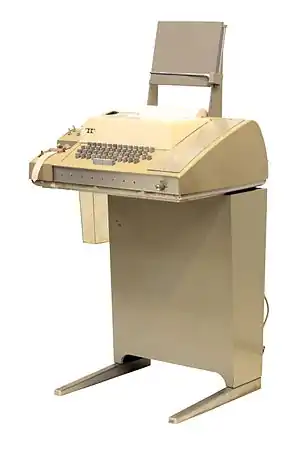PDP-9
The PDP-9, the 4th of the five 18-bit minicomputers produced by Digital Equipment Corporation, was introduced in 1966.[1]:P.10 A total of 445 PDP-9 systems were produced,[2] of which 40 were the compact, low-cost PDP-9/L units.[3]
 DEC Logo | |
| Developer | Digital Equipment Corporation |
|---|---|
| Product family | Programmed Data Processor |
| Type | Minicomputer |
| Release date | 1966 |
| Units sold | 445 |
| Media | Paper tape |
| Platform | DEC 18-bit |
| Mass | 750 pounds (340 kg) |
| Predecessor | PDP-7 |
| Successor | PDP-15 |
History
The 18-bit PDP systems preceding the PDP-9 were the PDP-1, PDP-4 and PDP-7. Its successor was the PDP-15.
Hardware
The PDP-9, which was "two metres wide and about 75cm deep,"[4] was approximately twice the speed of the PDP-7. It was built using discrete transistors, and had an optional integrated vector graphics terminal. The PDP-9 weighed about 750 pounds (340 kg)[5]:1-7 and the PDP-9/L weighed about 900 pounds (410 kg).[6]
It was DEC's first microprogrammed machine.[7][5]:3-6 through 3-59
A typical configuration included:[2]
- 300 cps Paper Tape Reader
- 50 cps Paper Tape Punch
- 10 cps Console Teleprinter, Model 33 KSR

Among the improvements of the PDP-9 over its PDP-7 predecessor were:
- the addition of Status flags for reader and punch errors, thus providing added flexibility and for error detection[8]
- an entirely new design for multi-level interrupts, called the Automatic Priority Interrupt (API) option
- a more advanced form of memory management[9]
User/university-based research projects for extending the PDP-9 included:
Software
The system came with a single-user Keyboard monitor. DECsys, provided an interactive, single user, program development environment for Fortran and assembly language programs.[12]
Both FORTRAN II[2] and FORTRAN IV[13] were implemented for the PDP-9.
MUMPS was originally developed on the PDP-7, and ran on several PDP-9s at the Massachusetts General Hospital.
Sales
The PDP-7, of which 120 were sold,[1]:p.8 was described as "highly successful.".[2] The PDP-9 sold 445 units. Both had submodels, the PDP-7A[NB 1] and the PDP-9/L,[NB 2] neither of which accounted for a substantial percentage of sales.[1][NB 3]
See also
- Programmed Data Processor
- PDP-15 - successor to the PDP-9
Notes
- sometimes identified by customers and media as PDP-7/A
- yes, DEC had a "slash" for the 9/L but not for the 7A
- directly mentioned for one, calculated in the other case
References
- DIGITAL EQUIPMENT CORPORATION - Nineteen Fifty-Seven To The Present (PDF). Digital Equipment Corporation. 1975.
- "RI Computer Museum, DEC PDP-9, System Number 319".
- ."The Early Architectures of DEC".
- "David Millson - 50 years".
- PDP-9 Maintenance Manual, Volume 1 (PDF). April 1972.
- PDP-9/L User Handbook (PDF). June 1968. p. 15-8.
- C. Gordon Bell; Gerald Butler; Robert Gray; John E. McNamara; Donald Vonada; Ronald Wilson (1978). "Chapter 6: The PDP-1 and Other 18-bit Computers". In C. Gordon Bell; J. Craig Mudge; John E. McNamara (eds.). Computer Engineering: A DEC View of Hardware Systems Design. Digital Press. pp. 154–155. ISBN 0-932376-00-2.
- Bob Supnik. "Architectural Evolution in DEC's 18b Computers" (PDF).
- "PDP 9 Simulator Configuration". GitHub.com.
- Ben Milton Huey (1969). "Design of a floating point processor for the PDP-9 computer". University of Arizona. Cite journal requires
|journal=(help) - Wokhlu, Roop Krishen (1969). "The logic design of a PDP-9 controlled parallel computer". Cite journal requires
|journal=(help) - Bob Supnik (19 June 2006). "Technical Notes on DECsys" (PDF).
- "User Manual - Linkage - PDP-9 Facilities" (PDF). Carnegie-Mellon University Hybrid Computation Laboratory. September 1968. Retrieved 19 September 2017.